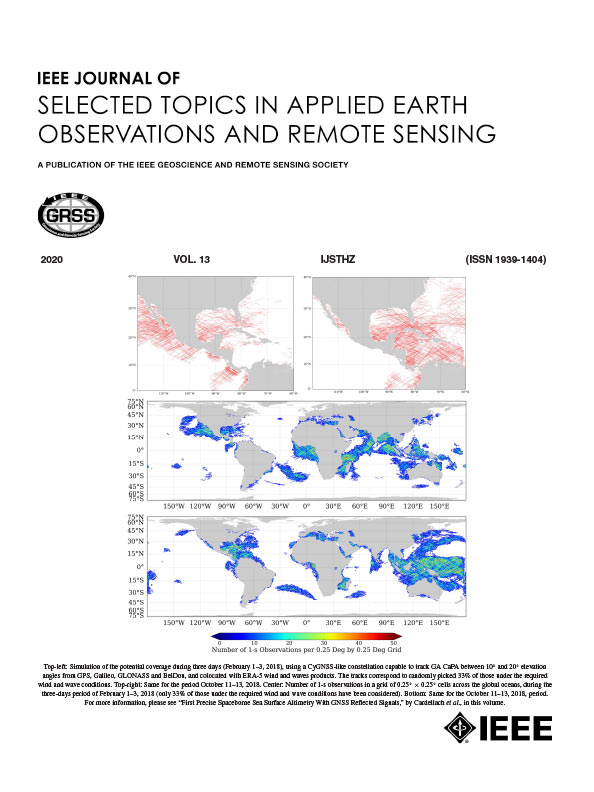SEMSF-Net:可解释的压缩激励多尺度融合网络,用于遥感影像的航景和海岸区域识别
IF 5.3
2区 地球科学
Q1 ENGINEERING, ELECTRICAL & ELECTRONIC
IEEE Journal of Selected Topics in Applied Earth Observations and Remote Sensing
Pub Date : 2025-06-18
DOI:10.1109/JSTARS.2025.3580801
引用次数: 0
摘要
在过去十年中,土地利用和土地覆盖分类在管理资源退化和减轻人口增长的影响方面发挥了关键作用。它被广泛应用于快速城市化、农业、气候变化、沿海地区和灾难恢复等领域。传统的遥感技术在对动态和复杂的海洋场景(如沿海地区和陆域地区)进行准确分类方面存在局限性。本文提出了一种新的挤压激励多尺度融合网络(SEMSF-Net),用于利用遥感图像对露露地和沿海地区进行分类。所提出的模型是基于最初分别嵌入初始和密集块的挤压和激励块。这些块是基于多尺度设计的,以生成更重要的特征信息,以便以后进行准确的分类。下一阶段,在网络层面对这些块进行融合,连接瓶颈和倒立残块,减少可学习参数,提高特征强度。该网络的超参数是根据模型训练中使用的几个实验来选择的。在测试阶段进一步使用经过训练的SEMSF-Net体系结构,并执行分类。GradCAM还用于解释训练模型的视觉预测。实验过程使用了三个数据集:Coastal dataset, MLRSNet和NWPU。在这些数据集上,我们分别获得了94.94%、93.7%和95.70%的提高准确率。宏观召回率分别为79.0%、93.0%和96%。与最近几种技术的比较表明,所提出的模型优于所选数据集。本文章由计算机程序翻译,如有差异,请以英文原文为准。
SEMSF-Net: Explainable Squeeze–Excitation Multiscale Fusion Network for Aerial Scene and Coastal Area Recognition Using Remote Sensing Images
Land use and land cover (LULC) classification has played a key role over the last decade for managing the decay of resources and mitigating the impact of population growth. It is used in several places, such as rapid urbanization, agriculture, climate change, coastal areas, and disaster recovery. The traditional remote sensing (RS) techniques encounter limitations in accurately classifying dynamic and complex ariel scenes, such as coastal areas and LULC. This article proposed a novel squeeze–excitation multiscale fusion network (SEMSF-Net) to classify LULC and the coastal regions using RS images. The proposed model is based on the squeeze-and-excitation block initially embedded with inception and dense blocks separately. These blocks are designed based on the multiscale to generate more important feature information that can later perform accurate classification. In the next phase, these blocks are fused at the network level, where bottleneck and inverted residual blocks are connected to reduce the learnable parameters and improve feature strength. The hyperparameters of this network are selected based on the several experiments utilized in the training of the proposed model. The trained SEMSF-Net architecture is further employed in the testing phase, and classification is performed. The GradCAM is also used to interpret the trained model’s visual prediction. Three datasets are utilized for the experimental process: the Coastal dataset, MLRSNet, and NWPU. We obtained an improved accuracy of 94.94%, 93.7%, and 95.70% on these datasets, respectively. In addition, the macro recall rates are 79.0%, 93.0%, and 96%, respectively. Comparison with several recent techniques shows that the proposed model outperforms the selected datasets.
求助全文
通过发布文献求助,成功后即可免费获取论文全文。
去求助
来源期刊
CiteScore
9.30
自引率
10.90%
发文量
563
审稿时长
4.7 months
期刊介绍:
The IEEE Journal of Selected Topics in Applied Earth Observations and Remote Sensing addresses the growing field of applications in Earth observations and remote sensing, and also provides a venue for the rapidly expanding special issues that are being sponsored by the IEEE Geosciences and Remote Sensing Society. The journal draws upon the experience of the highly successful “IEEE Transactions on Geoscience and Remote Sensing” and provide a complementary medium for the wide range of topics in applied earth observations. The ‘Applications’ areas encompasses the societal benefit areas of the Global Earth Observations Systems of Systems (GEOSS) program. Through deliberations over two years, ministers from 50 countries agreed to identify nine areas where Earth observation could positively impact the quality of life and health of their respective countries. Some of these are areas not traditionally addressed in the IEEE context. These include biodiversity, health and climate. Yet it is the skill sets of IEEE members, in areas such as observations, communications, computers, signal processing, standards and ocean engineering, that form the technical underpinnings of GEOSS. Thus, the Journal attracts a broad range of interests that serves both present members in new ways and expands the IEEE visibility into new areas.

 求助内容:
求助内容: 应助结果提醒方式:
应助结果提醒方式:


